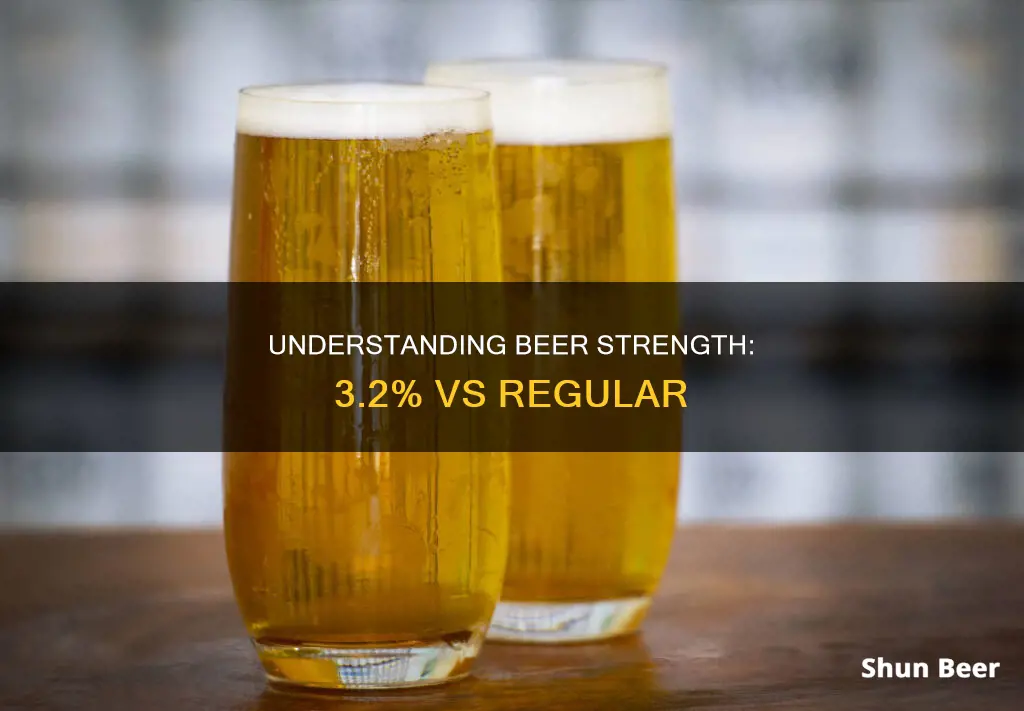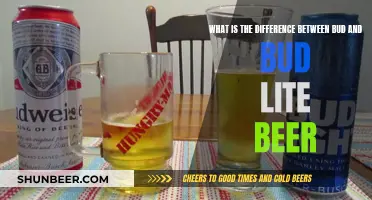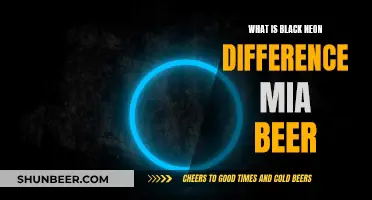
The difference between 3.2 beer and regular beer is a matter of alcohol percentage. 3.2 beer, also known as three-two beer or low-point beer, contains 3.2% alcohol by weight or 4% alcohol by volume. Regular beers typically have about 5% ABV. This difference in alcohol content means that 3.2 beer is weaker and less intoxicating than regular beer. However, when measured by volume, the difference between 3.2 beer and regular beer is less significant, with 3.2 beer containing only 1.5% less alcohol than some regular beers. Historically, 3.2 beer emerged in the 1930s after Prohibition, as a compromise between allowing alcohol consumption and maintaining some restrictions. Today, it is mainly found in certain states like Minnesota, which restrict grocery and convenience stores to selling beer with lower alcohol content.
| Characteristics | Values |
|---|---|
| Alcohol by volume | 3.2% beer: 4% |
| Regular beer: 5% | |
| Alcohol by weight | 3.2% beer: 3.2% |
| Regular beer: 4% | |
| Calories | 3.2% beer: fewer calories than regular beer |
| Availability | 3.2% beer: sold everywhere, including grocery stores |
| Regular beer: sold in state-licensed liquor stores |
What You'll Learn

3.2 beer is weaker than regular beer, but only slightly
2 beer, also known as three-two beer, light beer, or low-point beer, has 3.2% alcohol by weight (ABW) or 4% alcohol by volume (ABV). Regular beers typically have an ABV of 5%, so 3.2 beer is weaker than regular beer, but only slightly.
The difference in strength between 3.2 beer and regular beer is not as significant as it may seem, especially when comparing ABWs. When measured by volume, 3.2 beer contains 4% ABV, while regular beers typically contain 4.2% to 4.5% ABV. This small difference of around 1% ABV means that 3.2 beer is only slightly weaker than regular beer.
The perception of 3.2 beer as a "low-quality, weak or amateurish drink" is not entirely accurate, as the alcohol content is only slightly lower than that of regular beer. In fact, most people around the world consume light alcohol, with drinks in the range of 3.7% to 4.5% ABV being the most common.
The distinction between 3.2 beer and regular beer is further blurred by the fact that the standard measurement for alcohol content has changed over time. 3.2 beer originated in the 1930s, when alcohol content was measured by weight. Today, alcohol content is typically measured by volume, which yields a higher percentage for the same drink. So, when comparing 3.2 beer (4% ABV) to regular beers (typically 4.2% to 4.5% ABV), the difference is minimal.
In summary, while 3.2 beer is technically weaker than regular beer, the difference is minimal, and both types of beer fall into the category of light alcohol, which is commonly consumed worldwide.
Oktoberfest Beers: What Sets Them Apart?
You may want to see also

3.2 beer is measured by weight, regular beer by volume
2 beer is a relic from the Depression era, which will soon be disappearing. It is also known as "three-two" beer and is currently the standard grocery store option in Minnesota. The name comes from the fact that 3.2 beer contains 3.2% alcohol by weight. This is different from regular beer, which is measured by volume.
In the US, alcohol content is typically measured in terms of ABV (alcohol by volume). However, 3.2 beer is an exception, as it is an outdated drink that originated during Prohibition. When a beer advertises itself as 3.2%, it means that 3.2% of the total weight of the liquid is alcohol. This is an important distinction because alcohol is less dense than water, so the percentage by weight will be lower than the percentage by volume.
If we do the math, we find that 3.2% by weight is actually equivalent to about 4.0% by volume. This means that 3.2% beer has about 80% of the alcohol content of a typical 5% beer, rather than the 64% we would calculate if we assumed a linear relationship between weight and volume.
The 3.2% limit for beer was established in 1933, when President Franklin D. Roosevelt signed the Beer and Wine Revenue Act, which ended Prohibition. The specific alcohol limit was chosen as a compromise that could gather the necessary votes to pass the legislation. It was determined to be a non-intoxicating level of alcohol, although the science at the time was not very advanced.
Beer Carbonation: CO2 Content Varies by Brew
You may want to see also

3.2 beer is a relic of Prohibition
2 beer, or "three-two" beer, is a relic of the Prohibition era in the United States. During Prohibition, there was a federal ban on the manufacture, sale, and consumption of alcohol, which began with the Eighteenth Amendment to the US Constitution in 1919. However, even after Prohibition was repealed in 1933, many states continued to ban or restrict the sale and consumption of alcohol.
As a compromise between allowing alcohol and maintaining prohibition, some states began allowing the sale of beer with a low alcohol content of 3.2%. This type of beer was known as "three-two" beer because it contained 3.2% alcohol by weight (ABW), which was considered a low amount that would not easily intoxicate people. It was also referred to as a "non-intoxicating beverage."
The 3.2 beer designation was based on outdated standards of measuring alcohol content by weight rather than by volume (ABV). When measured by volume, 3.2 beer is equivalent to 4.0% ABV, which is not significantly different from regular beers, which typically have an ABV of around 4.2% to 4.5%.
Over time, public perception of 3.2 beer as a low-quality or weak drink led to its gradual regulation out of existence. As of 2021, Minnesota was the last state still requiring grocery and convenience stores to sell only 3.2 beer. However, even in Minnesota, there were reports of store owners having difficulty sourcing the product.
The history of 3.2 beer illustrates the complex relationship between alcohol regulation and consumption in the United States, with the legacy of Prohibition continuing to shape alcohol laws and drinking culture decades later.
Cerveza vs Beer: What's the Difference?
You may want to see also

3.2 beer is cheaper and has a lower calorie density
2 beer, also known as three-two beer, light beer, or low-point beer, has survived due to quirks of history and law, monopolistic interests, and bureaucratic apathy. It is a Depression-era relic that will soon disappear, with Minnesota being the only state left restricting convenience and grocery stores to selling it.
One of the benefits of 3.2 beer is its price. It is cheaper than stronger beers, making it a more affordable option for those looking to drink on a budget. This lower price point is advantageous for those who want to sip and enjoy a beer without getting drunk or breaking the bank.
Another advantage of 3.2 beer is its lower calorie density. Regular beer typically has an alcohol content of 5.0% ABV, while 3.2 beer contains 4.0% ABV or 3.2% ABW. This lower alcohol content results in fewer calories, making it a healthier option for those conscious of their calorie intake or watching their weight. For example, a 12-oz serving of Amstel Light, a popular regular beer, contains 95 calories. In contrast, a 3.2 beer would have a lower calorie count due to its reduced alcohol content.
The history of 3.2 beer is intriguing. It emerged in the 1930s after Prohibition, with its alcohol content deemed "non-intoxicating" by Anton J. Carlson, the University of Chicago's Physiology Department chairperson. This standard allowed people to drink and still walk in a straight line. The compromise of 3.2% was arbitrary, with no magical properties, but it satisfied the political process and gathered the necessary votes to legalise alcohol again.
Exploring Belgium's Diverse Beer Culture: A Tasty Overview
You may want to see also

3.2 beer is still sold in Minnesota
2 beer, or "three-two" beer, is a relic of the Prohibition era. It refers to the percentage of alcohol by weight, which is an old-fashioned way of measuring alcohol content. In modern terms, 3.2% by weight is around 4% alcohol by volume (ABV).
In the US, 3.2 beer has been largely phased out, with Minnesota being the last state to continue selling it in grocery and convenience stores. However, even in Minnesota, it is becoming harder to find, with some breweries discontinuing their 3.2% products.
The history of 3.2 beer in the US is a fascinating one. It dates back to 1933, when President Franklin D. Roosevelt signed the Beer and Wine Revenue Act, compromising on a limit of 3.2% alcohol by weight for beer. This was nine months before Prohibition was fully repealed, so there had to be a limit on alcohol content. The number was somewhat arbitrary, but it stuck, and many states adopted it as a standard even after Prohibition ended.
Over time, the 3.2 beer became a way to control alcohol consumption, especially among teenagers. In some states, it was the only alcoholic drink allowed, and it was easily accessible in grocery and convenience stores. However, the tide started to turn against 3.2 beer in the 1980s when the country adopted a uniform minimum drinking age of 21. States began to scrap special rules for 3.2 beer, and the brewers themselves found it a nuisance to produce.
Today, Minnesota is the last holdout, with a "three-two law" that restricts most alcohol sales to liquor stores. There is a push to change this law, with supporters arguing that it is outdated and that consumers should have more options. However, opponents worry about the impact on small businesses and the potential for increased alcohol consumption.
The debate around 3.2 beer in Minnesota is complex, involving politics, public health, and consumer choice. While some see it as a harmless quirk of history, others view it as a deceptive product that should be done away with.
Exploring the Diverse US Beer Scene
You may want to see also
Frequently asked questions
3.2 beer is a type of beer that contains 3.2% alcohol by weight (ABW) or 4% alcohol by volume (ABV). It is also known as three-two beer, light beer, or low-point beer.
Regular beers typically have an alcohol content of about 5.0% ABV. Therefore, 3.2 beer is weaker than regular beer.
3.2 beer is ideal for light drinking, as it allows you to drink without getting drunk. It is also cheaper, more widely available, and has a lower calorie density than stronger beers.
3.2 beer was created following the end of Prohibition in the 1930s as a compromise between allowing alcohol consumption and maintaining some restrictions. It was considered a "non-intoxicating" beverage.
As of 2021, Minnesota is the only state that restricts grocery and convenience stores to selling 3.2 beer. In other states, you may be able to find it in certain liquor stores or specialty retailers.







